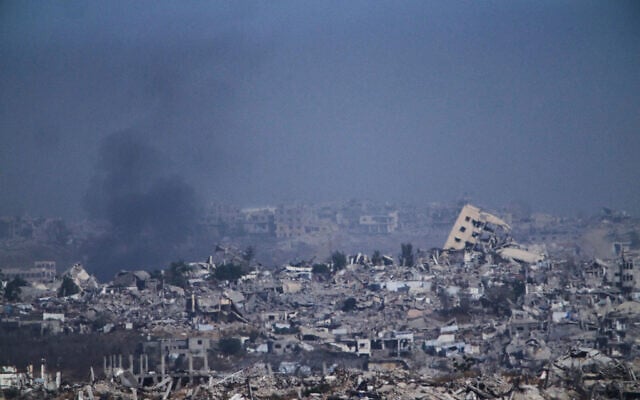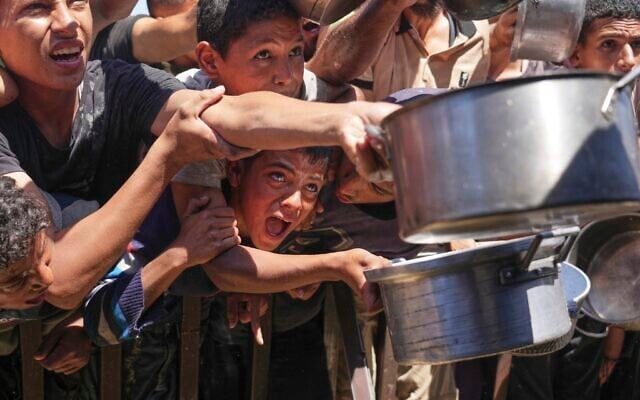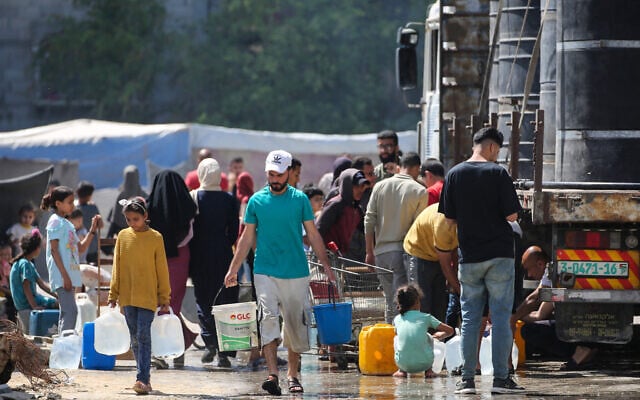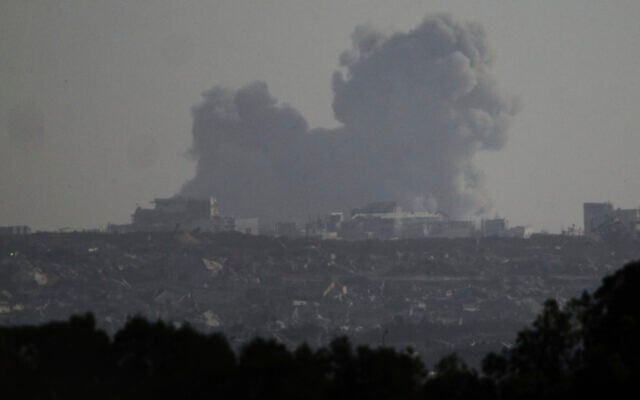



A controversial aid mechanism backed by Israel and the US and meant to help alleviate rampant hunger in the Gaza Strip began operating Monday, Israel said, as warplanes pounding the enclave killed dozens of people, according to Palestinians.
Prime Minister Benjamin Netanyahu’s office confirmed Monday morning that the distribution of assistance under the Gaza Humanitarian Foundation had begun, launching a system that Israel says is meant to keep aid from being diverted to the Hamas terror group.
Meanwhile, Israel’s air force said it had launched hundreds of strikes throughout the enclave over the past two days, including hitting a Gaza City school-turned-shelter that it said had been used by Palestinian terror groups. Authorities in the Hamas-controlled enclave reported at least 46 deaths from the Israeli strikes.
With pressure building over humanitarian conditions in the Strip, GHF said in a statement Monday that it would be opening the first of a number of planned distribution points within hours, and aid would reach at least a million Palestinians — about a half of the enclave’s population — by the end of the week.
The announcement came hours after foundation CEO Jake Wood abruptly resigned Sunday, saying it would be impossible to implement the plan while “strictly adhering to the humanitarian principles of humanity, neutrality, impartiality, and independence.”
While technically an American company, GHF was established in close coordination with Israeli authorities. Aid groups and the UN have refused to cooperate with the new initiative, saying it would create even more displacement of the Palestinian population, fail to meet local needs and violate humanitarian principles that prohibit a warring party from controlling humanitarian assistance.
Under the plan, preselected family representatives would be able to pick up boxes of food for their families from a small number of distribution sites in southern Gaza. The zones are secured and operated by private American security contractors, who arrived in the region earlier this month.
There was no immediate comment from the Israeli Defense Ministry’s Coordinator of Government Activities in the Territories, which manages the supply of humanitarian aid into Gaza.
Israel began allowing aid to trickle into the Strip last week, after cutting off deliveries of assistance since early March, when it abandoned a two-month ceasefire that saw an influx of food and other supplies into the Strip.
In recent weeks, experts have warned of a high risk of famine, and even the United States, a staunch ally, has voiced concerns over the hunger crisis.
GHF said Monday morning it was “disappointed” by Wood’s departure but would push ahead with the plan, accusing critics of being “afraid that new, creative solutions to intractable problems might actually succeed.”
“We will not be deterred. Our trucks are loaded and ready to go. Beginning Monday, May 26, GHF will begin direct aid delivery in Gaza, reaching over one million Palestinians by the end of the week. We plan to scale rapidly to serve the full population in the weeks ahead,” GHF said.
GHF was created earlier this year as Israel tried to advance a new mechanism for distributing humanitarian aid in Gaza that would prevent its diversion by Hamas, which Israel accuses of siphoning off aid, hoarding supplies, and selling them to pay its operatives.
Wood, a former Marine and social entrepreneur, before his resignation tried to dispel concerns about the mechanism when he announced that Israel had agreed to GHF’s demands to allow for the establishment of additional distribution sites throughout Gaza and to restart the distribution of aid through existing mechanisms last week until GHF is operational on the ground.
The decision to allow aid to start flowing again coincided with the start of the IDF’s new, major offensive in the Strip dubbed “Gideon’s Chariots,” the goal of which is to defeat Hamas, pressure the group to release 58 remaining hostages it is holding and retake security control of the Strip.
The military said on Sunday that it aims to occupy 75 percent of the Gaza Strip’s territory within two months in the new offensive.
As part of the offensive’s opening stages, the military has significantly stepped up its airstrikes across the war-torn enclave, deployed five divisions — or tens of thousands of troops — to the Strip, and is poised to launch a wide-scale ground maneuver.
The Israel Defense Forces said Monday morning that air force jets had carried out over 200 strikes in the Gaza Strip since Saturday, targeting terror operatives, weapon depots, anti-tank and sniper positions, tunnel shafts, and other infrastructure.
In southern Gaza, the military says troops struck a building used by Hamas as a weapons depot, an observation post, and another structure used by the terror group. Troops also directed drone strikes on several operatives spotted in buildings near the forces, the IDF says.
In northern Gaza, the IDF says a strike carried out by a fighter jet destroyed a building where members of Hamas’s elite Nukhba force were operating.
The army also confirmed hitting “key terrorists” embedded within the Al-Jarjawi School in Gaza City’s Daraj neighborhood, which had been converted into a shelter.
Local health officials said at least 31 people were killed in the strike, without specifying if they were civilians or combatants.
The military said the location had been used by Hamas and the Palestinian Islamic Jihad as a command center “to plan and gather intelligence in order to carry out terror attacks against Israeli civilians and IDF troops in the area.”
The army added that it had taken “many steps” to mitigate civilian harm, including by using a precision munition, aerial surveillance, and other intelligence. Israel blames Hamas for fighting within civilians areas.
Fahmy Awad, head of the Hamas-run Gazan health ministry’s emergency service, said the school was hit three times while people slept, setting their belongings ablaze.
Footage circulating online showed rescuers struggling to extinguish fires and recovering charred remains.
Shifa Hospital in Gaza City also reported 15 members of a single family killed in a strike on their home. There was no confirmation of either death toll.
Meanwhile, three projectiles were fired from Gaza at southern Israel, the army said Monday morning. Two of the projectiles fell short in Gaza, and the third was intercepted by air defenses before crossing the border.
Sirens did not sound in any border communities amid the attack.
This week will mark 600 days since war was sparked by Hamas’s invasion of southern Israel on October 7, 2023, during which some 1,200 people, most of them civilians, were killed and 251 kidnapped into the Strip. Israel says 58 hostages remain in Gaza, over half of whom are believed to be dead.
Jacob Magid, Nava Frieberg, Emanuel Fabian and agencies contributed to this report.





